6 BEST Therapist Invoice Templates to Ease Your Workload
Managing this administrative workload requires creative solutions so that you can dedicate more time to your customers. To make the process easier, here are six therapist invoice template examples.

According to Mind Money Balance, some mental health therapists have a caseload of 30-40 clients each week while others may see several hundred.
Depending on the type of therapy that the professional provides, too many patients will result in burnout. Therapists already face compassion fatigue especially if they see clients who have trauma.
But this burnout is also a result of the administrative work that comes with each client. Teletherapist Network indicates that those who aim for a 40-hour workweek would likely spend 10 hours on administrative tasks if they see up to 30 clients.
For someone that runs their own practice, having over 30 patients in a week would require over 10 hours of administrative tasks. The more patients there are, the more time spent on these tasks. So imagine how busy those therapy clinics would be if they see several hundred people in a week.
Unfortunately, caseloads are becoming heavier for therapists. As of 2019, close to 20% of American adults relied on mental health treatment.
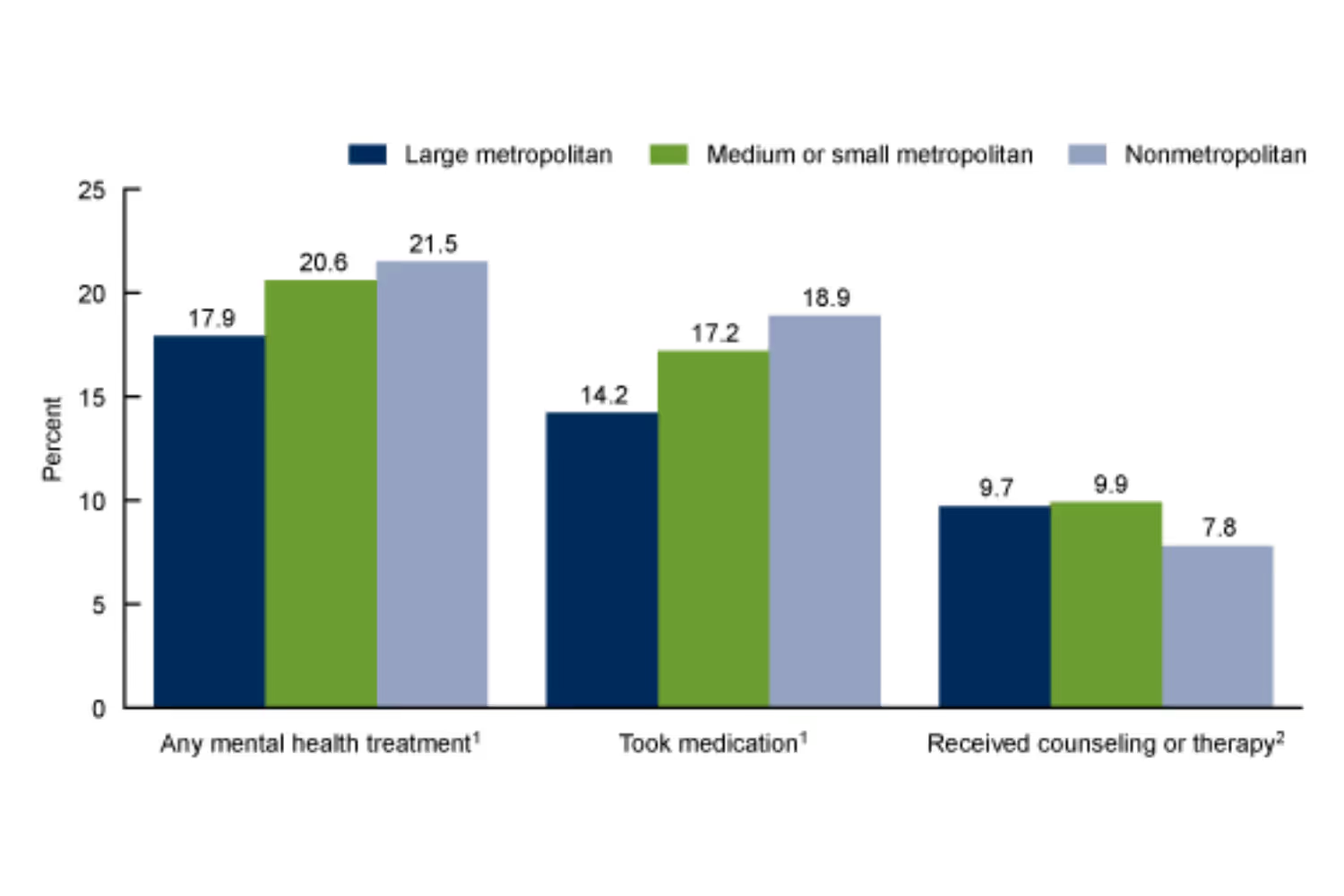
And since 2020, these numbers have drastically increased. One poll found that 74% of psychologists were seeing more clients with anxiety disorders and 60% said they had more clients with depressive disorders. Close to 30% saw an increase in patients overall.
This increase doesn’t even consider the fact that we need over 6,000 mental health providers to fill the shortage of care.
As more people need services and there are fewer professionals as options, the current working therapists will end up with larger caseloads. This means even more administrative work.
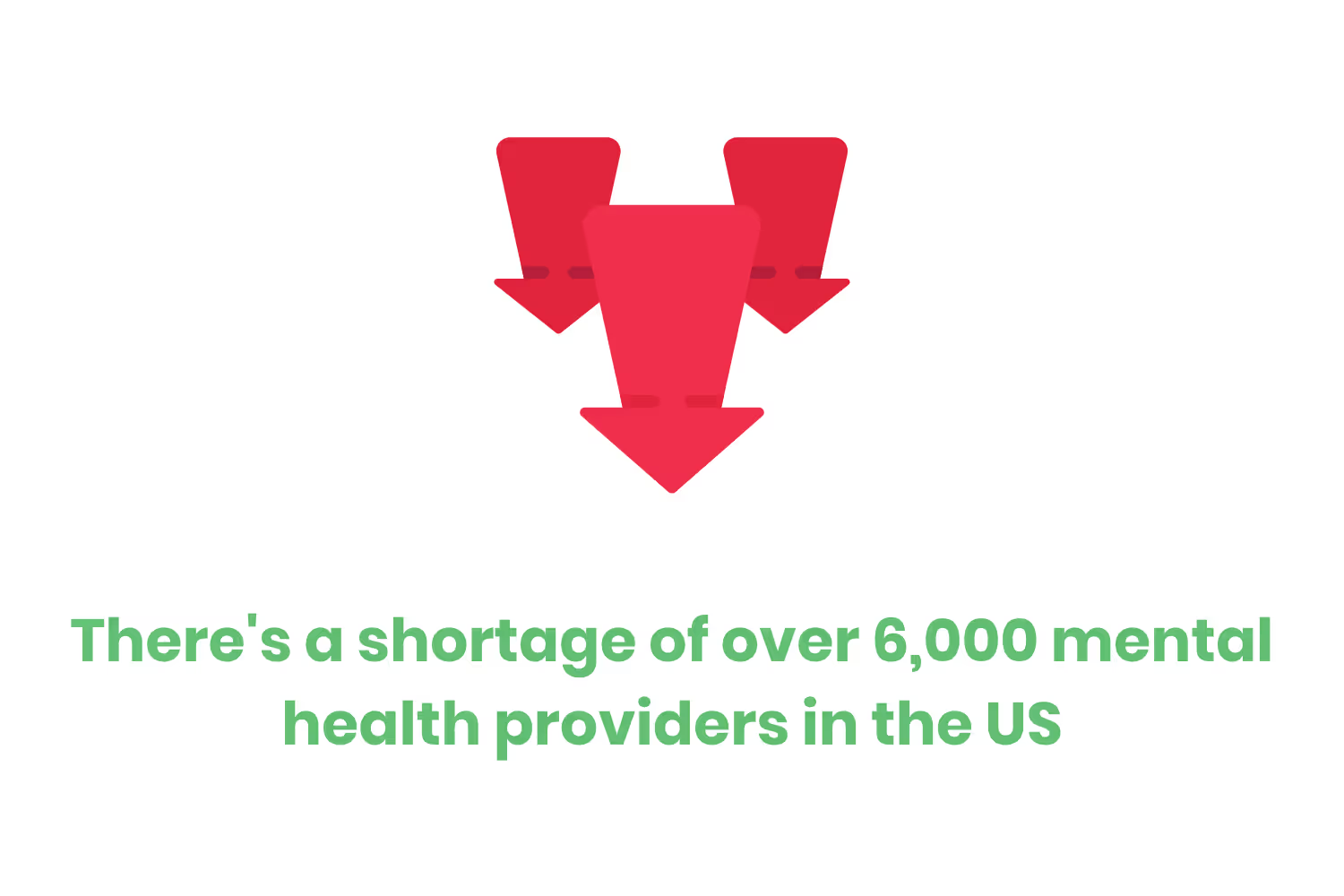
These tasks include medical billing. Whether you run your own practice or not, you still need enough time to manage and send invoices. This is how you get paid for your services.
Since so many more people rely on therapists, it leads to even more time dedicated to invoicing. What makes this an even bigger challenge is that schooling for these professionals doesn’t typically cover how to deal with collecting revenue from patients.
There’s so much involved in the billing process. The first step is coding each service so that insurance will accept the claim and reimburse what they owe you. Hopefully, this goes smoothly so that you don’t end up with denials.
But then, you also need to actually create and send an invoice to patients so that they’ll pay what they owe. This becomes a long process that could cause delays in revenue, especially if you’re struggling to keep up with all of your patients.
With that said, managing this administrative workload requires creative solutions so that you can dedicate more time to your customers. To make the process easier, here are six therapist invoice template examples.
Keep It Simple
Imagine you receive a bill cluttered with information. With so many words or graphics, it makes it hard to find the details that you need to pay. It would be quite frustrating if you’re spending too much time just trying to figure out how much you owe or what your options are for payment methods.
This is why it’s important to keep it simple. You know the stress that comes with making and sending invoices. It’s just as stressful for the recipient who would then have to decipher a confusing statement.
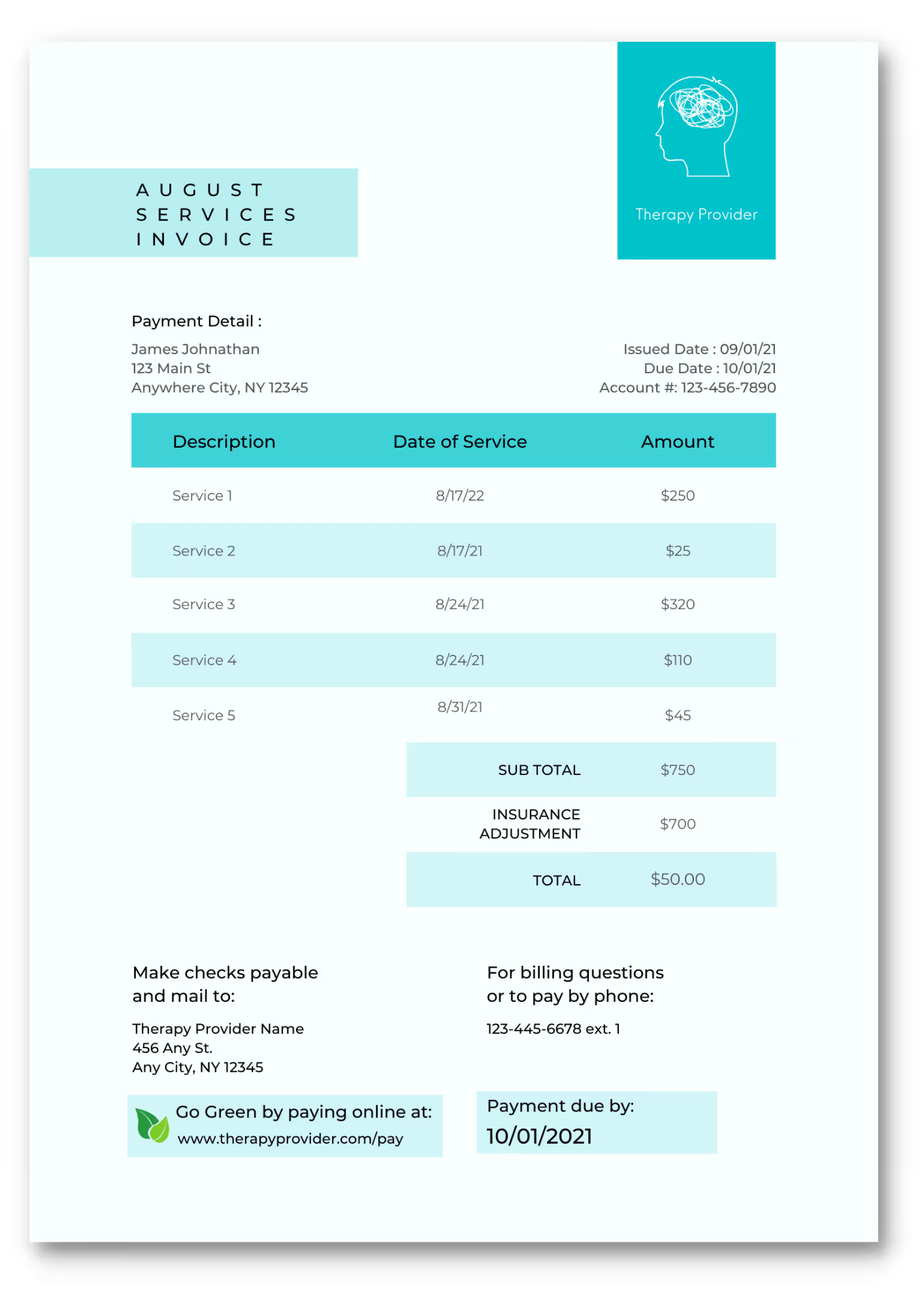
Not to mention that this would lead to more administrative work for you. If they don’t understand their statements, then they’ll be contacting your office for assistance. This takes up more of your time answering their questions.
These individuals are also coming to you for help with their mental health. It would be pretty ironic if your invoices just made them even more anxious and stressed.
This therapist invoice template uses only the basic information needed for a person to pay. That way, they can easily find and understand the most necessary details.
It also helps you get paid faster since they don’t need to contact you for any reason and can submit their payment as soon as they get their invoice.
Include Dynamic Messages
Including dynamic messages is helpful for any organization that needs to send invoices. You can change these messages depending on any details relevant to their statement or your practice.
They’re most useful as an additional reminder of when to pay. If they haven’t made their payments yet, then you’ll need to send another statement.
Within these dynamic messages, you can indicate if the invoice is a first, final, or past due notice. Since the client has these reminders on the statement itself, they’ll know the urgency of getting their money to you.

You can see in this example that the message is above the charge list. Since we read from top to bottom, the client will see this before they lose attention once they get to the final total and how to pay.
Because of the importance of these details, you need them to stand out and grab their attention. But these messages don’t only need to pertain to the due date.
If there are any important updates from your practice, you can interchange them here. For example, maybe you started accepting online payments. You can then use this area to encourage going green by enrolling in paperless billing.
Encourage Scheduling the Next Visit
Therapy sessions are different than just an annual checkup, but you already knew that. Many of your clients will be regular visitors for at least a brief period.
A study found that 50% of patients need an average of 15 to 20 sessions to recover. According to Solara Mental Health, sessions may be as frequent as multiple times in one week. Others are weekly, bi-weekly, or as-needed.
Some patients will visit a therapist for the rest of their lives. Because your clients are frequent visitors, you want to encourage them to get their appointments scheduled on time.
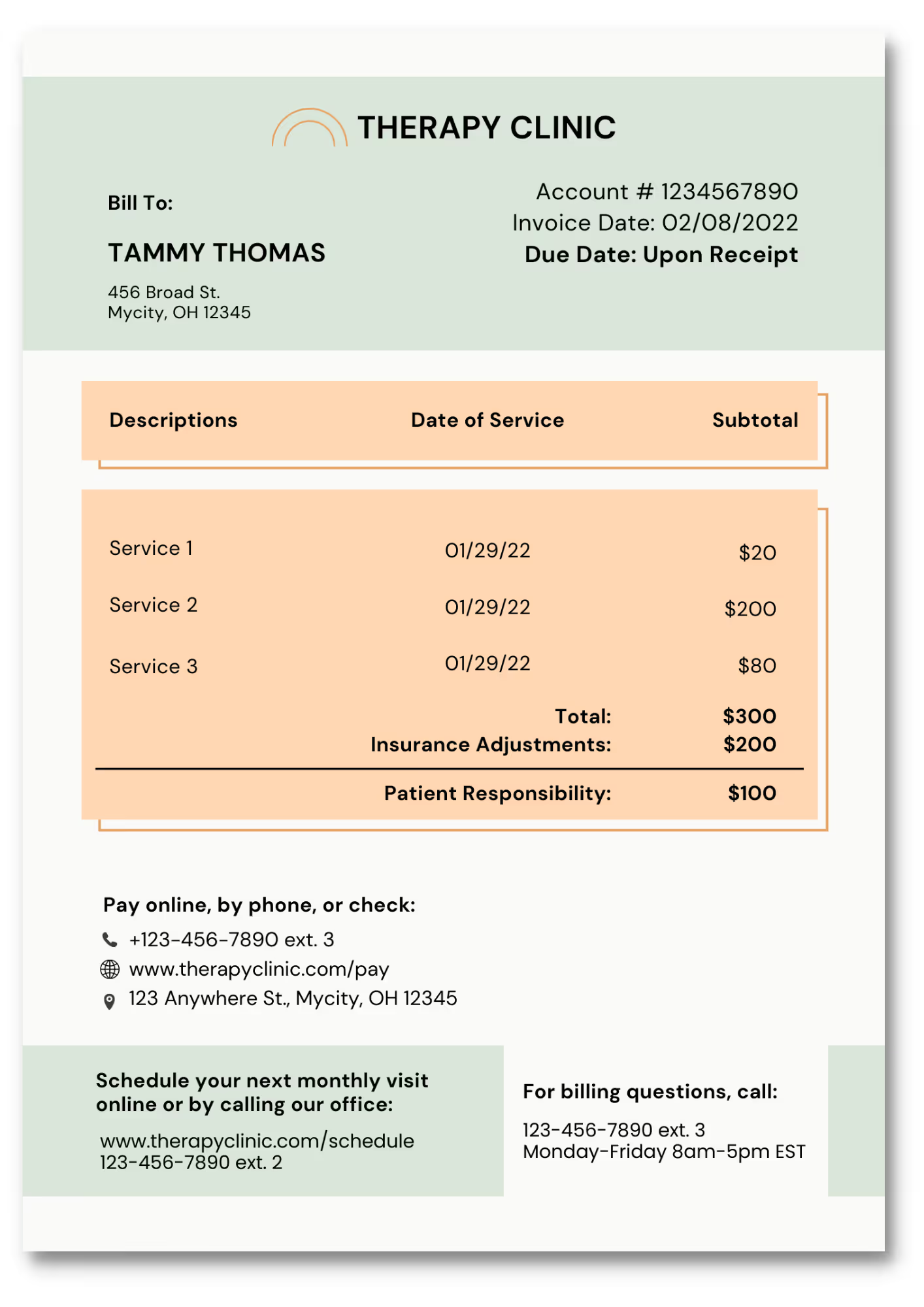
It takes more effort to try squeezing in their session if they didn’t call to schedule until right before they were due for the visit. But reminding them on their invoice that they need to schedule their next appointment will encourage them to do that early.
When you do include this note, make sure to let them know their options for how to schedule. If you have an online system, it takes even more tasks off of your workload since they won’t need to call to set up their next appointment.
Use a QR Code
QR codes offer easy access to company websites and online payments. If your practice isn’t implementing them in some way, it’s only a matter of time. After all, clients desire convenient options.
That’s why this therapist invoice template includes a QR code. As a provider, you can direct patients to different areas on your website. If you have an online payment option, you can use the code for this so clients can pay immediately.
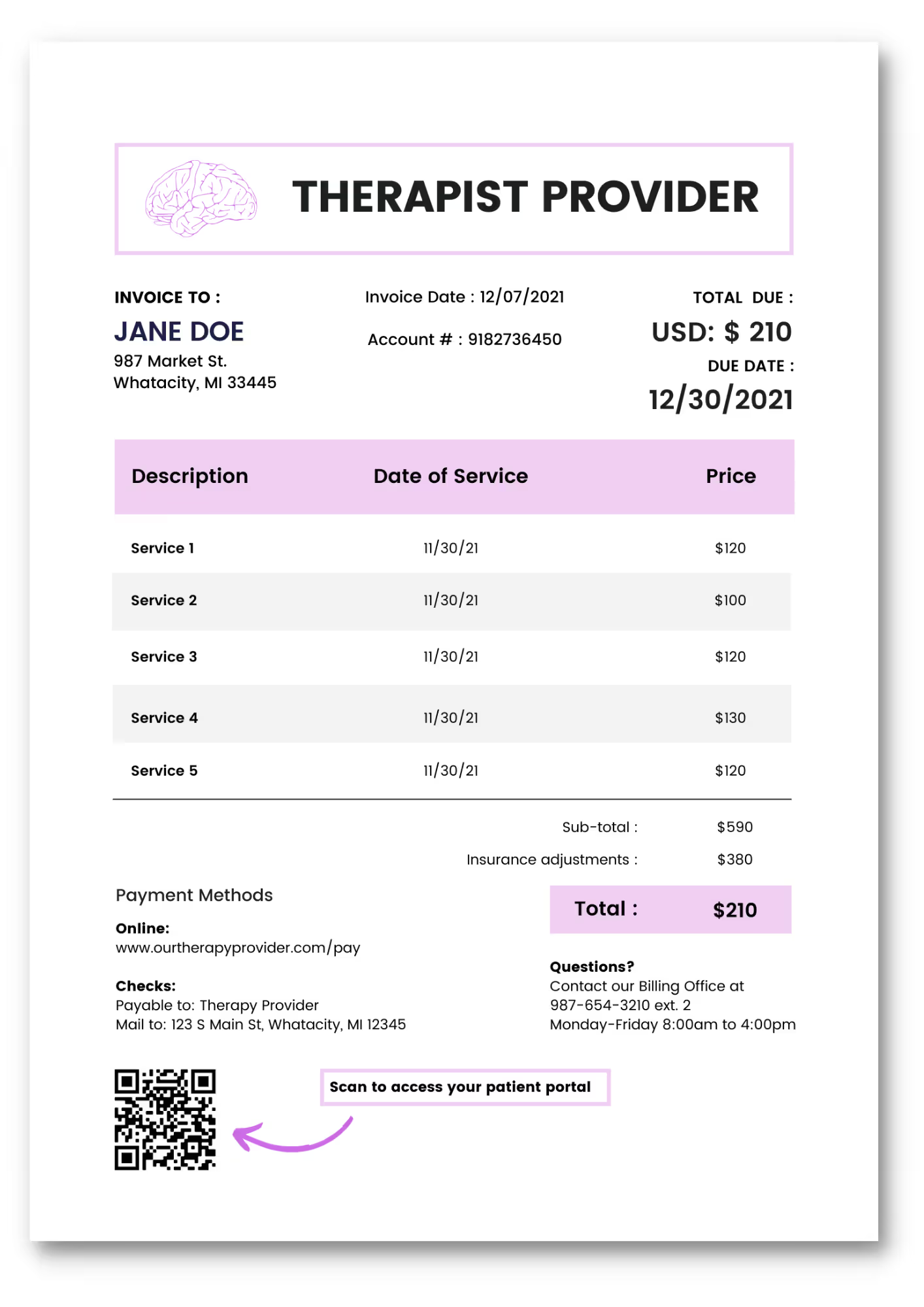
Since these codes can influence them to pay online, there are again fewer administrative tasks. You don’t need to handle cashing their checks, inputting their credit card numbers, or taking payments by phone.
You can also use a QR code to direct them to their patient portal so they can access anything else they might need, such as the online scheduling platform.
If they have access to everything they need online, they can manage certain tasks on their own. And using a QR code gets them to that site faster.
Focus on Design
The information on your statements isn’t the only aspect that makes them effective. You also need to focus on their design.
Different design elements make them both understandable and pleasing to look at. I already explained how if people don’t understand their bill, they either won’t pay it quickly or they’ll end up calling your practice with questions.
Incorporating certain design elements makes them easier to follow and helps the recipient find key details quickly. That way, they have no question about their charges, what they owe, or how to pay.
It’s just as important that they’re aesthetically pleasing. If they don’t stand out, then they could get lost in a stack of the recipient’s mail. Then they definitely won’t end up paying you on time.
Certain designs can also be more calming which is even more positive for these patients. These people are already seeing you due to mental health concerns. To make matters worse, 72% of Americans stress about money in a given month.

Because of these anxieties on top of already-existing mental health conditions, statements may easily end up overwhelming someone. This makes it even more important to use designs that are calming.
This therapist invoice template uses green, blue, and purple tints since those colors evoke feelings of calm while reducing stress and anxiety.
Black and White Still Works
Let’s say that you just don’t have it in your budget to print colored statements. As much as you wish you could afford these fancy designs, you need more simple therapist invoice templates.
The good news is that there are still options that will be practical and won’t take up too much effort. Black and white statements are just as effective if created the right way.
These invoices involve more than just typing up the information into a document. You’ll still need to use different elements and arrange the information on the page so that it’s attention-grabbing.
Emphasizing information and establishing a hierarchy with different shapes and sizes will get your clients to notice the most important details.

Electronic Invoices
If you don’t want to lose the value of colored statements but don’t want to pay the additional cost of printing, there’s an option that has even more value for you.
By using a payment processing solution (us), you can still send paper statements. But you can also present these bills online (we offer this). This allows you to implement your branding while also accelerating the payment process with an online portal like what I mentioned earlier.
This way, you get the best of both worlds with branded statements and an online payment collection service.
Conclusion
As a therapist, you have so much on your plate. That’s stating the obvious. With more people relying on your services, it can be difficult to keep up with your caseload since this also means more administrative work.
Since your schooling wasn’t focused on the medical billing process, it’s an even bigger hassle to create and send statements.
But it’s necessary, nonetheless. How would you collect your money if your patients didn’t receive a bill? Even when they do receive them, there’s still no guarantee that they pay you on time.
Confusing statements would cause more stress for clients or add to your workload when they contact you for clarification. If they don’t pay on time, you’ll also have to go through the process of sending reminders or even writing debt collection letters.
By using these templates as a guide, you’ll eliminate some of the extra work for you in the long run. It might take a bit of effort initially, but it reduces the effort over time. And if you don’t even want to go through that trouble, we can make it even easier with our comprehensive statement and invoicing solution.
Emphasize your product's unique features or benefits to differentiate it from competitors
In nec dictum adipiscing pharetra enim etiam scelerisque dolor purus ipsum egestas cursus vulputate arcu egestas ut eu sed mollis consectetur mattis pharetra curabitur et maecenas in mattis fames consectetur ipsum quis risus mauris aliquam ornare nisl purus at ipsum nulla accumsan consectetur vestibulum suspendisse aliquam condimentum scelerisque lacinia pellentesque vestibulum condimentum turpis ligula pharetra dictum sapien facilisis sapien at sagittis et cursus congue.
- Pharetra curabitur et maecenas in mattis fames consectetur ipsum quis risus.
- Justo urna nisi auctor consequat consectetur dolor lectus blandit.
- Eget egestas volutpat lacinia vestibulum vitae mattis hendrerit.
- Ornare elit odio tellus orci bibendum dictum id sem congue enim amet diam.
Incorporate statistics or specific numbers to highlight the effectiveness or popularity of your offering
Convallis pellentesque ullamcorper sapien sed tristique fermentum proin amet quam tincidunt feugiat vitae neque quisque odio ut pellentesque ac mauris eget lectus. Pretium arcu turpis lacus sapien sit at eu sapien duis magna nunc nibh nam non ut nibh ultrices ultrices elementum egestas enim nisl sed cursus pellentesque sit dignissim enim euismod sit et convallis sed pelis viverra quam at nisl sit pharetra enim nisl nec vestibulum posuere in volutpat sed blandit neque risus.

Use time-sensitive language to encourage immediate action, such as "Limited Time Offer
Feugiat vitae neque quisque odio ut pellentesque ac mauris eget lectus. Pretium arcu turpis lacus sapien sit at eu sapien duis magna nunc nibh nam non ut nibh ultrices ultrices elementum egestas enim nisl sed cursus pellentesque sit dignissim enim euismod sit et convallis sed pelis viverra quam at nisl sit pharetra enim nisl nec vestibulum posuere in volutpat sed blandit neque risus.
- Pharetra curabitur et maecenas in mattis fames consectetur ipsum quis risus.
- Justo urna nisi auctor consequat consectetur dolor lectus blandit.
- Eget egestas volutpat lacinia vestibulum vitae mattis hendrerit.
- Ornare elit odio tellus orci bibendum dictum id sem congue enim amet diam.
Address customer pain points directly by showing how your product solves their problems
Feugiat vitae neque quisque odio ut pellentesque ac mauris eget lectus. Pretium arcu turpis lacus sapien sit at eu sapien duis magna nunc nibh nam non ut nibh ultrices ultrices elementum egestas enim nisl sed cursus pellentesque sit dignissim enim euismod sit et convallis sed pelis viverra quam at nisl sit pharetra enim nisl nec vestibulum posuere in volutpat sed blandit neque risus.
Vel etiam vel amet aenean eget in habitasse nunc duis tellus sem turpis risus aliquam ac volutpat tellus eu faucibus ullamcorper.
Tailor titles to your ideal customer segment using phrases like "Designed for Busy Professionals
Sed pretium id nibh id sit felis vitae volutpat volutpat adipiscing at sodales neque lectus mi phasellus commodo at elit suspendisse ornare faucibus lectus purus viverra in nec aliquet commodo et sed sed nisi tempor mi pellentesque arcu viverra pretium duis enim vulputate dignissim etiam ultrices vitae neque urna proin nibh diam turpis augue lacus.



![[ANSWERED] What is a Long-Term Care (LTC) Pharmacy](https://cdn.prod.website-files.com/67e2b8210878abcba6f91ae6/68d687806a075a1cf64659b0_WhatisLongTermCarePharmacy_925.avif)
